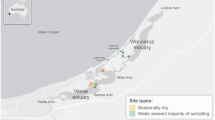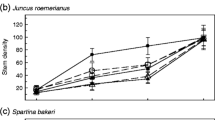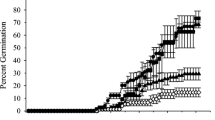Abstract
We describe effects of salinity and temperature on germination characteristics of three dominant macrophytes, Phragmites australis, Juncus acutus, and J. kraussii, located in wetlands along the Hunter River, New South Wales, Australia. These wetlands were altered, from estuarine to freshwater habitats, by flood mitigation activities initiated during the 1970s. Tidal restoration to approximately 300 hectares of the marsh is planned to occur by 2008, with the goal to reduce freshwater vegetation in favor of salt marsh species. We determined if timing restoration projects to coincide with natural germination cycles or seasonal conditions of high salinity would be disadvantageous to P. australis or J. acutus germination. Germination trials lasted 25 days under two temperature range treatments (10–25 and 15– 30°C) and a salinity gradient (0–30 ppt). Many P. australis seeds commenced decomposition after three days (up to 58%). Increased salinity lowered germination in all species; however, only P. australis was influenced by temperature. Phragmites australis germinated in all conditions, although germination rate was low (2% ± 1.7) in the highest salinity treatment at high temperature regime. Both Juncus species obtained 100% germination in freshwater, failed to germinate in the highest salinity, and seed viability was not affected by 25 days emersion in high salinity. For areas dominated by P. australis in eastern Australia, we suggest that tidal reinstatement should be initiated in late autumn when P. australis seed banks are low. Additionally, periods of heavy rainfall, which reduce soil salinity, may help other species colonize the area. Further studies are required to determine characteristics of J. acutus that can be used to repress the species spread along the eastern coast of Australia. Currently, active measures involving chemical and physical weed suppression, litter removal, and mass planting of native species, are likely to be required to achieve management goals.
Similar content being viewed by others
Literature Cited
Ailstock, M. S., C. M. Norman, and P. J. Bushmann. 2001. Common reed Phragmites australis: Control and effects upon biodiversity in freshwater nontidal wetlands. Restoration Ecology 9: 49–59.
Allison, S. K. 1996. Recruitment and establishment of salt marsh plants following disturbance by flooding. American Midland Naturalist 136: 232–247.
Auld, B. A. and R. W. Medd. 1987. Weeds: An Illustrated Botanical Guide to the Weeds of Australia. Inkata Press, Melbourne, VIC, Australia.
Bart, D. and J. M. Hartman. 2003. The role of large rhizome dispersal and low salinity windows in the establishment of common reed Phragmites australis in salt marshes: new links to human activities. Estuaries 26: 436–443.
Baskin, C. C. and J. M. Baskin. 1998. Seeds: Ecology, Biogeography, and Evolution of Dormancy and Germination. Academic Press, San Diego, CA, USA.
Bewely, J. D. and M. Black. 1994. Seeds: Physiology of Development and Germination, second edition. Plenum Press, New York, NY, USA.
Chiapusio, G., A. M. Sanchez, M. J. Reigosa, L. Gonzalez, and F. Pellissier. 1997. Do germination indices adequately reflect allelochemical effects on the germination process? Journal of Chemical Ecology 23: 2445–2453.
Ekstam, B. and A. Forseby. 1999. Germination response of Phragmites australis and Typha latifolia to diurnal fluctuations in temperature. Seed Science Research 9: 157–163.
Ekstam, B., R. Johannesson, and P. Milberg. 1999. The effect of light and number of diurnal temperature fluctuations on germination of Phragmites australis. Seed Science Research 9: 165–170.
Environment Australia. 1997. Wetlands Policy of the Commonwealth of Australia. Goanna Print, Canberra, ACT, Australia.
Fagan, R. H. and M. Webber. 1996. Global Restructuring: The Australian Experience. Oxford University Press, Melbourne, VIC, Australia.
Fowler, J., L. Cohen, and P. Jarvis. 1992. Practical Statistics for Field Biology, second edition. John Wiley and Sons, Chichester, Sussex, UK.
Galinato, M. I. and A. G. van der Valk. 1986. Seed germination traits of annuals and emergents recruited during drawdowns in the Delta Marsh, Manitoba, Canada. Aquatic Botany 26: 89–102.
Grillas, P., P. Garcia-Murillo, O. Geertz-Hansen, N. Marba, C. Montes, C. M. Durate, L. Tan-Ham, and A. Grossmann. 1993. Submerged macrophyte seed-bank in a Mediterranean temporary marsh: abundance and relationship with established vegetation. Oecologia 94: 1–6.
Harden, G. J. 1993. Flora of New South Wales. University of NSW Press, Sydney, NSW, Australia.
Harris, S. W. and W. H. Marshall. 1960. Experimental germination of seed and establishment of seedlings of Phragmites communis. Ecology 41: 395.
Hughes, C. E. 1998. Hydrology of a disturbed estuarine wetland, Hunter River, Australia: field investigation, process modelling and management implications. Ph. D. Dissertation. University of Newcastle, Newcastle, NSW, Australia.
Jones, V. and P. W. Richards. 1954. Juncus acutus L. Journal of Ecology 42: 639–650.
Keller, B. E. M. 2000. Genetic variation among and within populations of Phragmites australis in the Charles River watershed. Aquatic Botany 66: 195–208.
Kellogg, C. H., S. D. Bridgham, and S. A. Leicht. 2003. Effects of water level, shade and time on germination and growth of freshwater marsh plants along a simulated successional gradient. Journal of Ecology 91: 274–282.
Khan, M. A., B. Gul, and D. J. Webber. 2000a. Germination responses of Salicornis rubra to temperature and salinity. Journal of Arid Environments 45: 207–214.
Khan, M. A., I. A. Ungar, and A. M. Showalter. 2000b. Effects of salinity on growth, water relations and ion accumulation of the subtropical perennial halophyte, A triplex griffithii var. stocksii. Annals of Botany 85: 225–232.
Koppitz, H. 1999. Analysis of genetic diversity among selected populations of Phragmites australis world-wide. Aquatic Botany 64: 209–221.
Koppitz, H., H. Kuhl, K. Hesse, and J. G. Kohl. 1997. Some aspects of the importance of genetic diversity in Phragmites australis (cav) trin ex steudel for the development of reed stands. Botanica Acta 110: 217–223.
Lamp, L. and F. Collett. 1989. Field Guide to Weeds in Australia, third edition. Inkata Press, Melbourne, VIC, Australia.
Lenssen, J. P. M., G. E. ten Dolle, and C. W. P. M. Blom. 1998. The effect of flooding on the recruitment of reed marsh and tall forb plant species. Plant Ecology 139: 13–23.
Lissner, J. and H. H. Schierup. 1997. Effects of salinity on the growth of Phragmites australis. Aquatic Botany 55: 247–260.
MacDonald, T. A. 2001. Investigating the estuarine wetlands of the Lower Hunter River: rehabilitation potential of tidal reinstatement following degradation caused by tidal restriction. Ph. D. Dissertation. University of Newcastle, Newcastle, NSW, Australia.
Mauchamp, A. and F. Mesleard. 2001. Salt tolerance in Phragmites australis populations from coastal Mediterranean marshes. Aquatic Botany 70: 39–52.
Meyerson, L. A., K. Saltonstall, L. Windham, E. Kiviat, and S. Findlay. 2000. A comparison of Phragmites australis in freshwater and brackish marsh environments in North America. Wetlands Ecology and Management 8: 89–103.
Parsons, W. T. and E. G. Cuthbertson. 2001. Noxious Weeds of Australia, second edition. CSIRO, Collingwood, VIC, Australia.
Redondo, S., A. E. Rubio-Casal, J. M. Castillo, C. J. Luque, A. A. Alvarez, T. Luque, and M. E. Figueroa. 2004. Influences of salinity and light on germination of three Sarcocornia taxa with contrasted habitats. Aquatic Botany 78: 255–264.
Svoboda, P. 2004. Kooragang Wetland Rehabilitation Project Management Plan Revision: 1, Hunter-Central Rivers Catchment Management Authority, Tocal, NSW, Australia.
Thompson, K. and J. P. Grime. 1983. A comparative study of germination responses to diurnally-fluctuating temperatures. Journal of Applied Ecology 20: 141–156.
Wijte, A. and J. L. Gallagher. 1996. Effect of oxygen availability and salinity on early life history stages of salt marsh plants. 1. different germination strategies of Spartina alterniflora and Phragmites australis (Poaceae). American Journal of Botany 83: 1337–1342.
Williams, R. J., F. A. Watford, and V. Balashov. 2000. Kooragang Wetland Rehabilitation Project: History of changes to estuarine wetlands of the Lower Hunter River. NSW Fisheries, Port Stephens, NSW, Australia.
Wills, J. 1962. A Handbook of Plants in Victoria. Melbourne University Press, Melbourne, VIC, Australia.
Wright, D. A. and P. Wellbourn. 2002. Environmental Toxicology. Cambridge University Press, Cambridge, UK.
Xiong, S., M. E. Johansson, F. M. R. Hughes, A. Hayes, K. S. Richards, and C. Nilsson. 2003. Interactive effects of soil moisture, vegetation canopy, plant litter and seed addition on plant diversity in a wetland community. Journal of Ecology 91: 976–986.
Zedler, J. B., E. Paling, and A. McComb. 1990. Differential responses to salinity help explain the replacement of native Juncus kraussii by Typha orientalis in Western Australian salt marshes. Australian Journal of Ecology 15: 57–72.
Author information
Authors and Affiliations
Corresponding author
Rights and permissions
About this article
Cite this article
Greenwood, M.E., MacFarlane, G.R. Effects of salinity and temperature on the germination of Phragmites australis, Juncus kraussii, and Juncus acutus: Implications for estuarine restoration initiatives. Wetlands 26, 854–861 (2006). https://doi.org/10.1672/0277-5212(2006)26[854:EOSATO]2.0.CO;2
Received:
Revised:
Accepted:
Issue Date:
DOI: https://doi.org/10.1672/0277-5212(2006)26[854:EOSATO]2.0.CO;2




